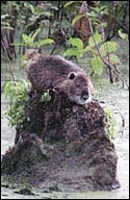Invasive Species
Introduction | Species Info | Teacher Materials | Resources
Species Information: Nutria
 The wetlands that fringe our coastal estuaries, rivers and floodplains perform many valuable functions contributing to the health of our watersheds. In many cases around the country, these wetlands are disappearing at alarming rates. Louisiana, for example, has lost about 25 square miles of coastal land each year from 1983 – 1990. Subsidence and compaction, natural parts of the delta cycle, are the primary causes of the sinking of Louisiana’s coastal lands and of the subsequent retreat of Louisiana’s coastline. However, land loss rates in Louisiana are influenced by a number of other factors, including the grazing of marsh vegetation by a large population of an invasive species, the nutria. Besides accelerating coastal land loss, this exotic species is also responsible for the decline of the muskrat, a species native to the Gulf Coastal Plain.
The wetlands that fringe our coastal estuaries, rivers and floodplains perform many valuable functions contributing to the health of our watersheds. In many cases around the country, these wetlands are disappearing at alarming rates. Louisiana, for example, has lost about 25 square miles of coastal land each year from 1983 – 1990. Subsidence and compaction, natural parts of the delta cycle, are the primary causes of the sinking of Louisiana’s coastal lands and of the subsequent retreat of Louisiana’s coastline. However, land loss rates in Louisiana are influenced by a number of other factors, including the grazing of marsh vegetation by a large population of an invasive species, the nutria. Besides accelerating coastal land loss, this exotic species is also responsible for the decline of the muskrat, a species native to the Gulf Coastal Plain.
Nutria, Myocastor coypus, are large South American rodents that have a stocky body, short neck, webbed feet and inch-long, dark orange incisors. Known in some places as “swamp beavers,” these semi-aquatic rodents are found in a variety of wetland habitats, ranging from marsh (salt, brackish, intermediate and fresh) to freshwater forested wetlands. Nutria reach sexual maturity at six months of age and breed year-round with an average litter of four to five offspring. Although the young are nursed, as are other mammals, baby nutria also begin to feed on marsh grass days after birth. Adult nutria weigh about 15 pounds and have a plush, velvety fur beneath their coarse guard hairs.
